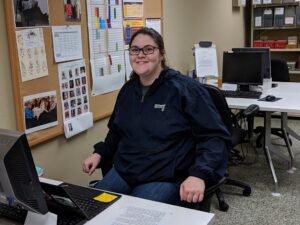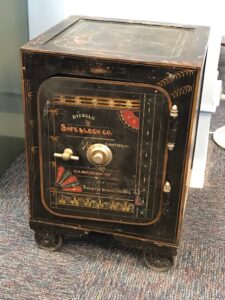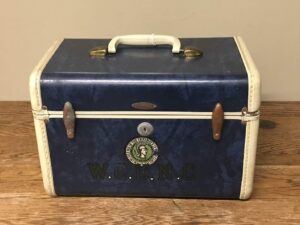
*Sarah Maske is a senior at UNC Greensboro, with a double major in history and archaeology. She is interning in the Martha Blakeney Hodges Special Collection and University Archives for the spring 2019 semester.
 |
| SCUA intern, Sarah Maske |
This semester, I am interning in the Martha Blakeney Hodges Special Collections and University Archives (SCUA) for HIS 390, a course offered by the History Department as a way for students to gain experience in the Public History field. My main project is to process material for the University Archives artifact collections. I am two and a half months into my semester long internship and I have loved every minute of my time here. The last four years I have spent a lot of time researching in the archives, but to work inside the stacks and to be a part of caring for a collection is a whole new experience for me.
I want to share some of what I learned about processing materials, and what it is like working with artifacts related to the University. Archival processing is essentially how materials are added to an archival collection. I found that researching the origins of an artifact and its significance to the University is my favorite part of the internship. Nevertheless, this is also one of the most frustrating parts of processing because sometimes it is hard to track the history of an artifact. Yet when your research is fruitful, it is so exciting!
 |
| Diebold Safe |
When I am researching, I try to picture what type of life the artifact had. I sometimes wonder if an artifact was a person what stories it would tell. My favorite books as a child were the Strange Museum series by Jahanna N. Malcolm. The series was about two siblings who lived above a museum, and if they touched an artifact after the museum closed, they would travel back in time to meet the artifact’s owner. When I am processing an artifact I always think about this series. It is moments when I am struggling to find information on an artifact that make me wish time travel was not limited to a work of fiction.
So far, I have processed or reprocessed, at least 50 artifacts and each are unique in their own way. Some artifacts are connected to buildings (you would be surprised by how many bricks are in the artifact collection), while others are connected to a single student or faculty member. Some are important awards and others seem like the most obsolete objects, such as laundry cards. As a researcher with an archaeology background, I find these little artifacts rich resources to understand the everyday life of the students. For example, a laundry card contains a list of different articles of clothing, so as a researcher the card illustrates what types of clothing were popular in the 1940s.
 |
| Woman’s College Make-Up Case |
Sometimes I think about what artifact I could add to the collection that would be memorable and aid a researcher in understanding what it was like to be a student on campus in 2019. Would my flyer I kept from a lecture on Roman pigments or my Honors Ambassador name tag be helpful to a future researcher? To be honest, I keep a lot of objects and notes from my time at UNC Greensboro. Any flyer from an important event or course notes go in chronological order to be packed away in my room at home. At times, I worry that I toe the fine line between hoarder and collector. Anyone else would throw it all away, but I would like to think someone in the future, who thinks like me will think my notes from my courses and keepsakes are interesting. As someone who is actively using the artifact collection, I am appreciative of the people who thought to donate their buttons, rain caps, stickers, toasters, and paperweights. Each one of these artifacts lets me see a small glimpse into the past.
Every time I work in the archives, I experience something new. SCUA has a wide variety of artifacts, whether it’s bricks from demolished buildings, a makeup case, a handkerchief from a former Queen of England, or even an antique crib. One day, I might crawl under a chair to look for manufacturer’s markings and the next day box buttons from the most recent campus event. I am so lucky to work with artifacts that have interesting histories. Working with the University Archive Collection has helped me grow as a public historian, and I am forever grateful to SCUA for this experience.